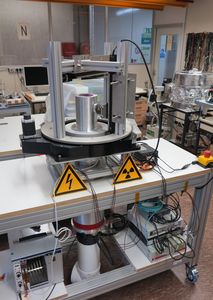The K2 test facility is based on a conventional vacuum cryostat cooled by an electrical cooling system. Integrated into the cryostat system is electronics readout for up to 20 channels. This allows for the readout of segmented detectors.
The cryostat is surrounded by a system of three automated stages. The complete mantle and one of the detector end-plates can be scanned. This facility works with gamma sources for which the energy is high enough to penetrate the thin aluminium wall of the cryostat. The lowest energies used are the weak 53 keV and the strong 81 keV lines from 133Ba. A Barium source is ideal as it also features a strong line at 356 keV. The low-energy gammas probe the regions underneath the surface of a detector while the high-energy gammas probe the bulk.
The special feature of this facility is that the temperature of the detector can be set. Thus, this setup is ideal to study the temperature dependence of the performance of germanium detectors. The K2 facility was built to follow up the results obtained with the K1 facility. The main result on this topic obtained from data taken with K1 is that the mobility of electrons in germanium does not follow the predicted T3/2 dependence but rather shows a Boltzmann like behaviour. The first publications using K2 are under preparation.
Key publications
Alpha-event and surface characterisation in segmented true-coaxial HPGe detectors
Nucl. Instrum. Meth. A 858 (2017) 80-89
The GALATEA test-facility for high purity germanium detectors
Nucl.Instrum.Meth. A 782 (2015) 56
Measurement of the temperature dependence of pulse lengths in an n-type germanium detector
Eur. Phys. J. Appl. Phys. 56 (2011) 10104
Pulse shape simulation for segmented true-coaxial HPGe detectors
Eur. Phys. J. C 68, 609-618 (2010)
Neutron Interactions as Seen by A Segmented Germanium Detector
Eur. Phys. J. A 36, 139-149 (2008)
Characterization of the first true coaxial 18-fold segmented n-type prototype detector for the GERDA project Nucl.Instrum.Meth. A 577 (2007) 574
Key publications
Alpha-event and surface characterisation in segmented true-coaxial HPGe detectors
Nucl. Instrum. Meth. A 858 (2017) 80-89
The GALATEA test-facility for high purity germanium detectors
Nucl.Instrum.Meth. A 782 (2015) 56
Measurement of the temperature dependence of pulse lengths in an n-type germanium detector
Eur. Phys. J. Appl. Phys. 56 (2011) 10104
Pulse shape simulation for segmented true-coaxial HPGe detectors
Eur. Phys. J. C 68, 609-618 (2010)
Neutron Interactions as Seen by A Segmented Germanium Detector
Eur. Phys. J. A 36, 139-149 (2008)
Characterization of the first true coaxial 18-fold segmented n-type prototype detector for the GERDA project Nucl.Instrum.Meth. A 577 (2007) 574
